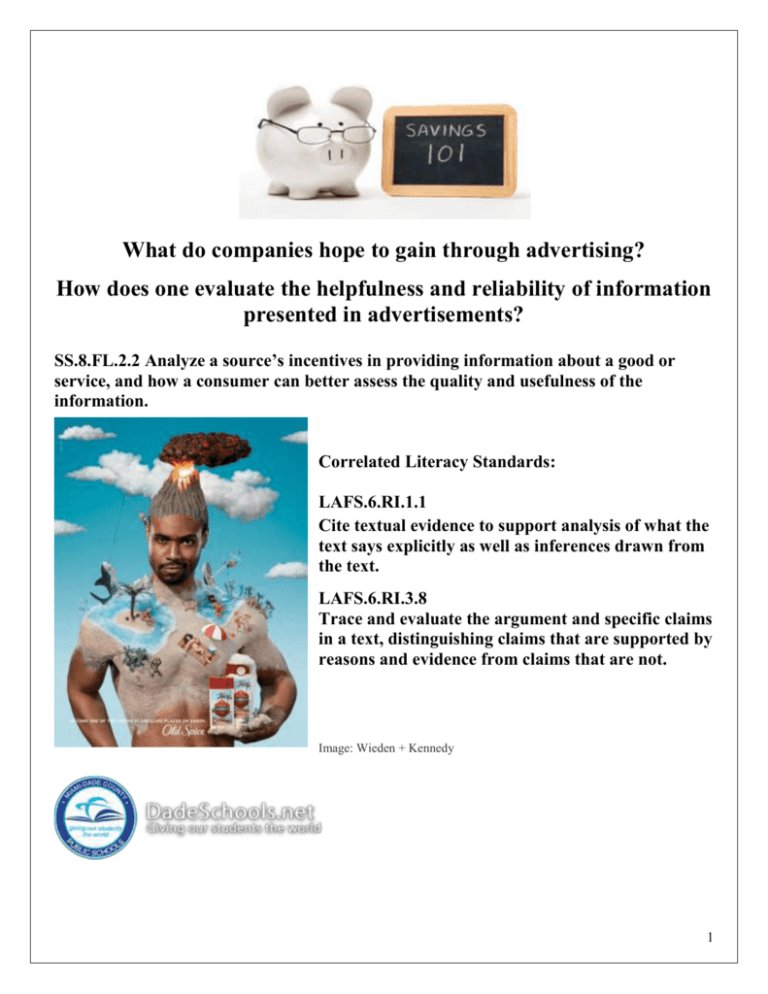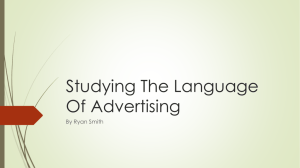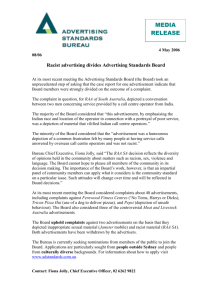Lesson PlanAnalyzing AdvertisementsGr6
advertisement

What do companies hope to gain through advertising? How does one evaluate the helpfulness and reliability of information presented in advertisements? SS.8.FL.2.2 Analyze a source’s incentives in providing information about a good or service, and how a consumer can better assess the quality and usefulness of the information. Correlated Literacy Standards: LAFS.6.RI.1.1 Cite textual evidence to support analysis of what the text says explicitly as well as inferences drawn from the text. LAFS.6.RI.3.8 Trace and evaluate the argument and specific claims in a text, distinguishing claims that are supported by reasons and evidence from claims that are not. Image: Wieden + Kennedy 1 SS.8.FL.2.2 Analyze a source’s incentives in providing information about a good or service, and how a consumer can better assess the quality and usefulness of the information. Analyzing Advertisements: They Said…Whaaat? Grade 6 Lesson Plan Correlated Florida Standards (See Full Text on Cover Page) LAFS.6.RI.1.1 LAFS.6.RI.3.8 Essential Questions What do companies hope to gain through advertising? What techniques do advertisers use to sell their products or services? How does one evaluate the helpfulness and reliability of information presented in advertisements? Learning Goals/Objectives Identify companies’ motives for advertising. Understand how businesses get consumers to purchase their products Evaluate the helpfulness and reliability of information presented in advertisements Complete a “Document Analysis” of a print advertisement Overview Students will discuss and evaluate the motivations and incentives for advertising. They will then review a variety of print advertisements, discuss advertising techniques, analyze the advertisements, and complete a document analysis worksheet for a selected advertisement. Materials Handout #1 “The Why and Where of Advertising” (included) PowerPoint Presentation: Advertising and Persuasive Techniques http://teach.clarkschools.net/jbernhard/literacy_web/persuasion/CommonPersuasiveTechniques.ppt Reliable Source Comparison Sheet (included) Newspaper or Magazine Ads (Either have these available in the classroom, or assign students to bring them from home- see Home Learning) Document Analysis Worksheet (included) Time 50 minutes Activity Sequence INTRODUCTION/HOOK Tell students that today’s class will be devoted to advertising. Brainstorm as to what advertising means. Then ask students if they think they are affected by advertising? Why or Why not? (2 minutes) Now tell students that you are going to present some phrases. They are to respond with their first thought when they hear the phrase. 2 “Have it your way” (Burger King) “Zoom, zoom” (Mazda) “I’m loving it” (McDonald’s) “Eat fresh” (Subway) “Taste the rainbow” (Skittles) “It’s way better than fast food” (Wendy’s) “Just do it” (Nike) “Keeps going and going and going” (Energizer) “Finger lickin’ good” (KFC) “Melts in your mouth, not in your hands” (M&Ms) “You’re in good hands with…” (Allstate) Tell students that the above phrases are all advertising slogans. How many did they know? Research showed that exposure to advertising slogans influenced personal spending intentions and also influenced actual spending behavior. (3 minutes) ACTIVITY 1. The Why and Where of Advertising. Distribute Handout #1 “The Why and Where of Advertising.” Discuss why companies advertise and the different modes of advertisement. Have students fill out the grid on the handout. Provide time for follow-up discussion (Answer Guide with Possible Solutions included) (8 minutes) 2. View and Discuss PowerPoint Presentation – Persuasive Techniques Used in Advertising. The ppt will introduce different advertising techniques and give examples of each. Students will then be given a number of advertisements to analyze. For each advertisement, students are to determine its’: a) purpose; b) target audience; and c) persuasive technique. (PowerPoint by Jennifer Bernhard Literacy Specialist Clark County Schools) (12 minutes) 3. Reliable Sources: The Federal Trade Commission, or FTC, works to protect consumers from being hurt by advertising. According to the Federal trade commission: “Advertisers are required by law to tell the truth, and that most advertisers work hard to do this. At the same time, the government does not review ads before they run. That’s why it’s important for students to ask three key questions when they see ads. 1) Who is responsible for the ad? 2) What is the ad actually saying? 3) What does the ad want me to do?” Explain to students that companies often use endorsements as product recommendations. Ask students why it is important to consider the expertise of the source to recommend a product. Would you purchase a medication for an upset stomach on the recommendation from your postal carrier? Maybe not, yet many people would purchase it because their favorite basketball player recommended it. Is either qualified to make the recommendation? Distribute (or Project on the Smart board) the “Reliable Source Comparison Sheet. Read and discuss with students (10 minutes) CLOSURE Distribute advertisements to students. Have them analyze their particular advertisement and complete the Document Analysis Worksheet. Provide time for students to share their work. Review the Lesson’s Essential Questions. (20 minutes) 3 OPTIONAL EXTENSION SUGGESTION/HOME LEARNING Home learning assignment for this lesson should be given the previous day. Students are to bring in a print advertisement for analysis in class. Suggestions: magazine or newspaper ad; junk mail advertisement Home Learning/extension Assign students to view and analyze a television commercial. Have them answer the following questions: What product or service was advertised? Was a slogan and/or jingle used? If so, what was the slogan or jingle? What advertising technique(s) were used? Explain how the technique was used. Who was the target audience for the advertisement? What might the commercial be conveying about the people who use this product or service? Did the commercial have an endorsement? If so, was the endorsement a reliable source? What television show(s) was/were on before and after the commercial? Did you enjoy or like this commercial? Why? 4 HANDOUT # 1: THE “WHY” AND “WHERE” OF ADVERTISING Manufacturers advertise so that they can: introduce people to their new product or service increase the demand for an existing product or service make sure that people are aware of and continue to buy their service or product especially when there are many similar products and services available. INCREASE PROFIT Try and fill the grid below with the names of places where or ways in which, you have experienced advertising. (See examples to get started) Bus shelter Newspapers Billboards Adapted from:ConsumerClassroom.eu 5 Possible Answers to Handout #1 You will find below a completed grid, but this is not meant to be an exhaustive list. You or your students may come up with alternative answers. Ask students to fill in the grid with places or ways in which they experience advertising in their everyday lives. You may need to prompt students to get them thinking after they have written down some of the more obvious ones. TV commercials Sporting occasions Signs Taxis E-mail Cars / Vans Radio Shopping bags Magazines Movies Buses Logos Food packets/ boxes Buses Billboards Internet Bus Stops Newspapers Flyers Trucks Video Games Airports Clothes Mobile phones Adapted from:ConsumerClassroom.eu 6 Reliable Sources The following images are actual celebrity endorsement advertisements. Do you think each of the celebrities is a “reliable source” to recommend the product? Why or Why not? Former NFL Quarterback Joe Namath for Beautymist Pantyhose (Yes, those are actually his legs in the pantyhose) Justin Bieber for Nicole Nail Polish Ozzie Osbourne for I Can’t Believe It’s Not Butter Charles Barkley for Weight Watchers Reliable Source or Not? Doctor recommending heartburn medication Appliance Repairman recommending mouthwash Astronaut giving tax advice Dentist recommending a toothpaste Media Specialist recommending a book Carpenter giving sewing tips Ballerina recommending sports equipment Accountant recommending tax preparation services ____________ ____________ ____________ ____________ ____________ ____________ ____________ ____________ Give 5 examples of reliable sources for product recommendations (list source and product) 1.____________________________________________ 2._____________________________________________ 3._____________________________________________ 4._____________________________________________ 5. _____________________________________________ Always remember to ask three key questions when you consider advertisements. 1) Who is responsible for the ad? 2) What is the ad actually saying? 3) What does the ad want me to do?” 7 Document Analysis Worksheet 1. Type of Document 2. What Company produced the advertisement? 3. What product or service is being advertised? 4. What is the target audience for this advertisement? What makes you think that? 5. What techniques does the advertisement use? 6. What does the ad say about the product or service advertised? 7. Do you consider this ad helpful? Why or Why not? 8. If the ad had a product recommendation, do you consider the source reliable> Why or Why not? 9. What are 2 things you found interesting about the ad? 10. As an informed consumer, would you purchase this product or service based on this advertisement? Why or Why not? 8





